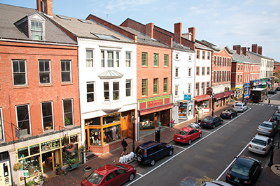
According to new figures from the Local Data Company (LDC) and British Independent Retailers Association (BIRA), traditional independent retailers opened more shops than they closed in 2016 across Great Britain.
Data released today by the two groups revealed the positive trend amongst indies, whilst the national chains continued to see a fall. Independent shops saw an increase of +159 shops (+0.15%) in 2016, which equates to a +36% increase from 2015, where +117 shops were added across Great Britain.
The chain retailers have remained in decline with a net loss of -896 shops in 2016 across the top 500 town centres, which compares to -498 shops in 2015.
In 2016, a total of 29,083 independents either opened (14,621) or closed (14,462), down on 2015 where 29,936 shops opened (15,026) or closed (14,910).
Service retail businesses with +587 units during the year, up from the +385 increase in 2015. Key growth sectors within this category have been barbers, hair and beauty salons. Comparison goods (non perishable goods) shops, which includes DIY and garden retailers, saw a net change of -2.01% in 2016, with a net decrease of -635 units, an increase on from -487 in 2015. However, the sectors seeing the greatest decline in this category include newsagents, women’s clothing, Indian restaurants and night clubs.
Regionally, the East Midlands showed the greatest increase of independents at +87 units (+1.19%) in 2016, versus +17 units (+0.23%) in 2015.Greater London, meanwhile, continues to see the greatest decline of independents at -154 units (-0.48%), but at a slower rate than in 2015 (-212 units, -0.65% in 2015).
Scotland has seen a boost in its number of independents with an increase of +130 units in 2016 compared to an increase of +75 units in 2015.Glastonbury boasts the highest percentage of independents at 85.6%, while Salford is the town with the lowest percentage of independents at only 18.1%, against a GB average of 65%. These figures are based on locations in the top 500 town centres.
Wider analysis of in and out of town locations shows that High Streets saw an improvement from a net increase of +119 units, to a net increase of +167 units in 2016. This represented a +40.3% increase year on year.
The other location types saw less of an overall change with shopping centres still recording a net decline of -0.22% (versus +0.02% in 2015) and Retail Parks edged in up by +9.09% (versus -14.81% in 2015) although these locations types make up under 5% of the total Independent market.
Independents account for 65% of all retail and leisure units in Great Britain, the same as in 2015.
LDC director Matthew Hopkinson commented: “Independents are becoming ever more important to our High Streets. Year by year, the net gain of small businesses is accelerating, even as the net loss of chain stores increases. They are changing the face of our towns as well, as barbers and bars replace clothing shops and newsagents, with service and leisure gradually substituting for comparison shops.
“Not all towns, or even regions, are benefiting from that growth, though. The East, South East and South West of England saw a fall in the numbers of independents in 2016. None, though, saw as big a fall as Greater London, with its rising rents. That challenge is to be amplified over the next five years by rising rates bills as well.”
He added: “The high levels of openings and closures among independents must be seen as a sign of continued buoyancy in our towns. But there is no room for complacency – with a gain on balance of just 159 shops on the back of more than 29,000 openings in 2016, it would take very little for net gains to become net losses.”
BIRA CEO Alan Hawkins said: “It’s good to have some positive news at last, especially in Scotland. It’s clear that the real winners are those areas where the customer has to be present such as hair and beauty. Service, leisure and convenience stores all showed good positive net openings with only comparison shops doing worse. The truth that most BIRA members are in this oddly-named category is an issue we and our members are working hard to redress.
“Given that there are over 100,000 independents in the top 500 towns, this is news to celebrate, as is that 65% of all retail and leisure outlets are independents. The fact that net growth is still in the low hundreds means no letup in our effort to convince government that support is needed. Without them it would be a much emptier exchequer. The next few LDC surveys will make interesting reading as the government has failed to deliver the fundamental rates reform we were looking for and we expect some economic realities to hit home.”
BIRA is hosting its annual conference on May 8, offering insight that will help shape the future of an independent retail business and with experts from the retail industry sharing ideas on how to further meet the needs of customers in the current era of change.
For more information and to register to attend the BIRA Conference, visit bira.co.uk/event/conference17/ or contact Pauline Swiech on 0121 446 6688 or events@bira.co.uk